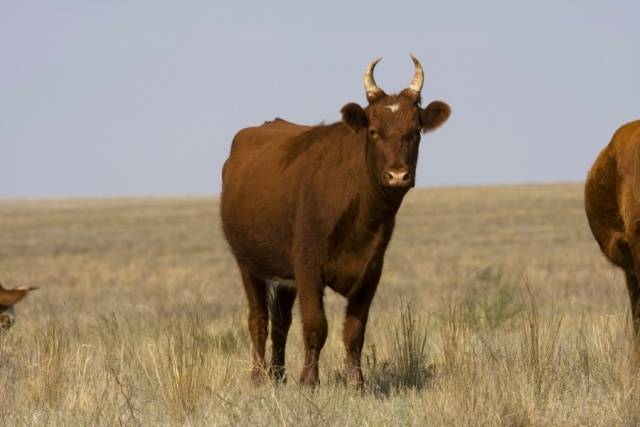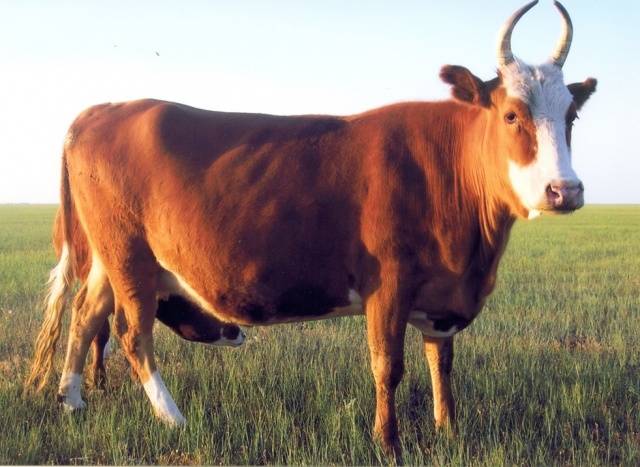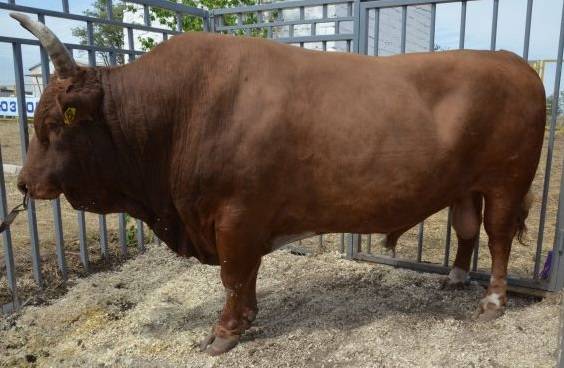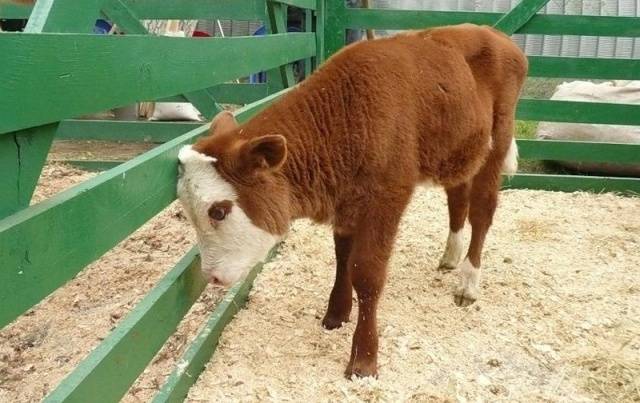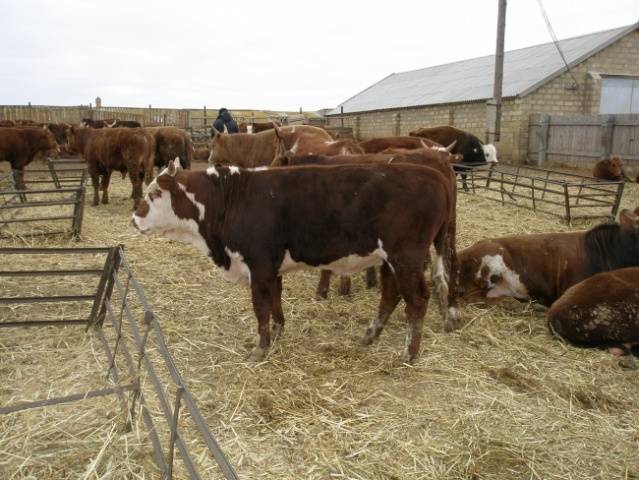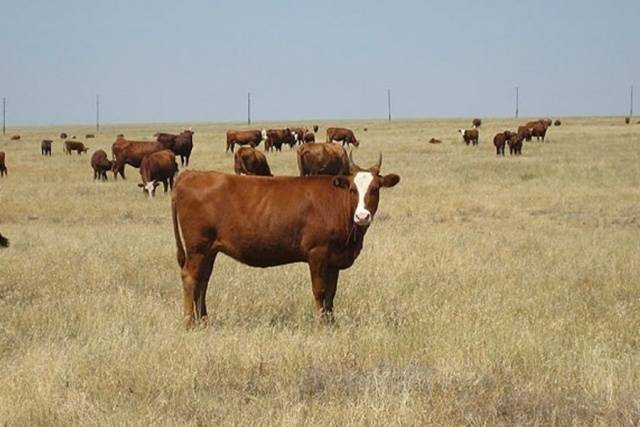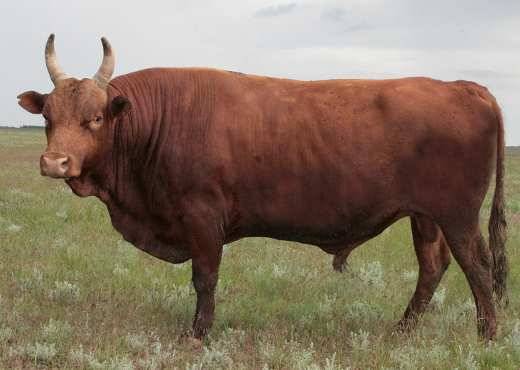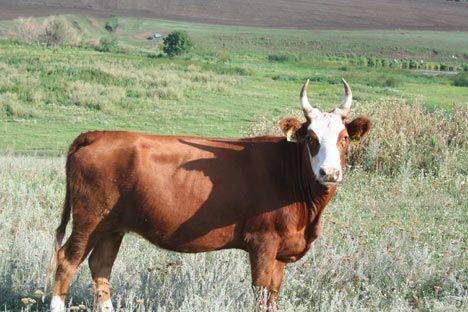Content
The Kalmyk cow is one of the ancient beef cattle breeds, presumably brought to the Kalmyk steppes by the Tatar-Mongols. More precisely, nomads-Kalmyks who joined the Tatar-Mongol horde.
Previously, the Kalmyk tribes lived in the harsh conditions of Southern Altai, Western Mongolia and Western China. Like any nomads, the Kalmyks did not care too much about livestock, leaving the animals to get food on their own both in summer and in winter. Summer and winter jutes "taught" animals to quickly gain fat in case of hunger strikes and to do with a minimum of feed of not the best quality. And also formed endurance during long crossings. In search of food, a Kalmyk cow can walk up to 50 km a day.
Description of the breed
Animals with a strong constitution. They have a harmonious build. They are very mobile. The Kalmyk breed of cows is not very large in stature. Height at withers 126-128 cm. Oblique length 155-160 cm. Stretch index 124. Chest girth 187 ± 1 cm. Metacarpus girth 17-18 cm. Bone index 13.7. The skeleton is thin and strong.
The head is medium-sized, light. Even bulls have crescent-shaped horns. The color of the horns is light gray. The nasal mirror is light. The neck is short, thick, with well-developed muscles. The withers are wide and well defined. The rib cage is shallow. The ribs are barrel-shaped. The chest is well developed, especially in bulls. The back is straight and wide. The rump is either flush with the withers in cows, or below the withers in bulls. The croup is straight. Legs are long, well set.
The color of Kalmyk cows is red. Possible white markings and bumps on the head, lower body, tail and legs.
Productive characteristics
Since the breed is for meat production, its milk yield is low, only 650 to 1500 kg of milk with a fat content of 4.2-4.4%. The lactation period for a Kalmyk cow is 8-9 months.
These calves are representatives cattle they also prefer to keep them to themselves, driving away even their own masters from them.
In terms of meat characteristics, this breed is one of the best bred in Russia. Adult cows weigh on average 420-480 kg, bulls 750-950. Some manufacturers can weigh more than 1000 kg. Calves weigh 20-25 kg at birth. By the time of weaning at 8 months, their weight already reaches 180-220 kg. By the age of 1.5-2 years, gobies of the Kalmyk breed already reach a weight of 480-520 kg. In some cases, the average daily weight gain can reach 1 kg. Slaughter yield from properly fed animals is 57-60%.
The photo shows one of the modern breeding bulls of the Kalmyk breed.
The early maturing type is smaller and has a lightweight skeleton.
The beef obtained from Kalmyk cattle has a very high taste. The need to survive has led to the emergence of Kalmyk cattle to accumulate fat in all possible places. A fattened animal can have up to 50 kg of internal fat. Apart from the subcutaneous and the one that accumulates between the fibers of the meat. It is thanks to the fat deposited between the muscle fibers that the famous "marble" meat is obtained from Kalmyk bulls.
Sire bulls
Pluses of the Kalmyk breed
The difficult living conditions for several centuries had a positive effect on the reproductive abilities of Kalmyk cattle. Kalmyk cows are distinguished by high insemination rate: 85-90%, and easy calving, due to the fact that they had to do without human help for centuries and calve in the steppe open to all winds. Calves are not very susceptible to colds.
For the winter, Kalmyk livestock grows overgrown with a thick undercoat, which allows it to spend the night in the snow without consequences. Kalmyk cows are protected from the cold not only by the undercoat, but also by the thick layer of subcutaneous fat that they grow up over the summer. Due to its large fat reserves, a Kalmyk cow can lose up to 50 kg of weight before calving, and this will not in any way affect the quality of the calf and the amount of milk.
Kalmyk livestock can survive on a very meager forage base. In the summer he wanders along the burnt-out steppe, in the winter he digs out dry grass from under the snow. The only danger for Kalmyk herds is jute. "Black" jute in summer, when the grass burns out due to drought, not having time to grow. And "white" jute in winter, when the snow is covered with a thick crust of crust. During such periods, a very large number of livestock die of hunger without human feeding. Not only cows die, but also sheep and horses, if they are kept on "free" grazing.
Living in a harsh continental climate, the breed has the ability to tolerate both heat and cold well. It is believed that this is facilitated by the special structure of the skin: near each hair there is not one sebaceous duct, like in other breeds, but several.
Kalmyk cattle breed belongs to the group of breeds that can be improved, only spoiled. It has no competitors in deserts, semi-deserts and arid steppes. Therefore, Kalmyk cattle are preserved as a source of genetic material used in breeding other breeds.
At the end of the 20th century, attempts were made to "improve" the Kalmyk breed by crossing cows with Shorthorn and Simmental bulls. The result was unsatisfactory, and in most of Russia today they prefer to breed purebred Kalmyk cows. Purebred cattle surpass Shorthorns and Simmentals in their beef characteristics.
The disadvantages of the breed today include only an overdeveloped maternal instinct, which previously helped to protect calves from wolves, and today threatens the life of the owner of the cow.
Feeding features
Cows of this breed are able to eat even feed that is not suitable for cattle, including semi-shrubs. One of the best properties of the breed, highly appreciated by farmers, is the ability of livestock to feed on grass alone, without the need for concentrated feed. A farmer's main expense at this time of year is the purchase of salt for the cows.
With a lack of water, animals stop eating, and therefore, become thin. The daily water requirement depends on the body weight of the animal:
- up to 250 kg - at least 40 liters of water;
- up to 350 kg - not less than 50 liters;
- over 350 - at least 60 liters.
It is rational to introduce such restrictions when there is a lack of water in pastures. If there is enough water, animals should drink plenty.
Reviews of the owners of Kalmyk cattle
Conclusion
Kalmyk cattle are ideal for breeding by large farmers or agricultural complexes, especially located in the steppe regions of Russia. Although this breed easily takes root even in rather harsh northern regions, there it needs additional feeding with grain, which increases the cost of obtaining beef. For a private trader, it is rational to keep a cow of this breed if he only counts on getting meat from her. Although you can try to get milk from especially docile or lost calves.

